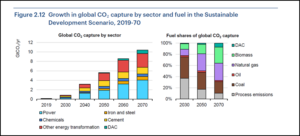New IEA Report: One Take on the Sustainable Energy Economy
By Stephen H. Crolius on September 17, 2020
Last week the International Energy Agency released Energy Technology Perspectives 2020. IEA Director Fatih Birol struck an upbeat note in the report’s Foreword:
Today, I am increasingly optimistic about the world’s clean energy future, despite the grave challenges we face. ETP-2020 shows that we know what needs to be done to develop and deploy the technologies that can put emissions on a sustainable path. The spectacular success of solar PV in becoming the cheapest source of power in many economies and the impressive rise of offshore wind demonstrate the ability of clean energy technologies to break through if governments put in place the right policies to support their expansion.
International Energy Agency, Energy Technology Perspectives 2020, September 2020
The 395 pages that follow provide abundant support for Birol’s positive view, describing in detail the technologies and systems that can be – and indeed are being – deployed to achieve net-zero energy-related greenhouse gas emissions by 2070 (“Sustainable Development Scenario”) or 2050 (“Faster Innovation Case”).
In common with many recent projections, the IEA scenarios envision electricity as the mainstay of a sustainable energy economy: “Spreading the use of electricity into more parts of the economy is the single largest contributor to reaching net-zero emissions.” But while the idea of a major role for electricity seems now to be widely accepted, consensus may be slower to form around other parts of the IEA scenarios.
Whereas at 48% electricity has by far the largest share of final energy consumption in the Sustainable Development Scenario, fossil fuels and bioenergy occupy the number two and three positions, with 20% and 14%, respectively. “Hydrogen-related” is fourth at 13%. (This category includes hydrogen, ammonia, and “synthetic fuels” made from “low-carbon hydrogen and sustainable carbon sources.”) This means that fully a third of final energy consumption will be based directly on carbon chemistry — a result that may seem counterintuitive, given carbon’s role in creating the climate crisis. The key, in the IEA scenarios, is to cast the fossil and bioenergy segments as two interlocking parts of one solution.

The expedient at the interface between fossil and bioenergy is carbon capture, utilization, and storage (CCUS). The Sustainable Development Scenario posits the capture of 10 GT of CO2 in 2070 in the course of energy-related activities. (Global CO2 emissions were approximately 37 GT in 2019). Of this, “more than 90% [will be] stored,” presumably in permanent geological structures. The remaining 1 GT will be utilized, with the lion’s share going to make synthetic kerosene for the aviation sector. All of the carbon used on this path will come either from direct air capture or from capture during biomass energy processing. The Sustainable Development Scenario also envisions capture of biomass carbon for storage. This action will create a source of negative emissions that will offset CO2 that eludes capture during fossil fuel use.

By contrast, hydrogen is cast in a much more circumscribed role, as “an option to decarbonise sectors where few alternative mitigation solutions exist, such as long-distance transport, chemicals, and iron and steel production.” Hydrogen’s application in these sectors is projected at only 10% of final energy use. The report does point to “increasing shares of variable renewables in the electricity generation mix” and acknowledges that hydrogen “is one of the very few technology options for storing large amounts of electricity over days, weeks or even months.” And it states that “hydrogen or hydrogen-based fuels can also be a means to transport renewable energy from regions with abundant renewable resources over thousands of kilometres to regions and cities with growing energy needs.” Nonetheless, hydrogen’s use as a medium for stored electricity is quantified only indirectly in an accounting footnote. This use and “onsite hydrogen production in the industry sector” together account for only 3% of final energy consumption. The implication is that in most cases it will be less costly to manage the intermittency of wind and solar with thermal generation (today’s practice) than to use hydrogen or ammonia as energy storage media.

The Sustainable Development Scenario does have one significant job for ammonia: fuel for maritime shipping. The scenario calls for ammonia to meet “almost half of all shipping fuel demand in 2070.” While ammonia is seen as providing only 1.4% of final energy demand at that point, the physical quantity required equates to 167 million tonnes of oil-equivalent (Mtoe) — roughly double the amount of ammonia produced today.
Scenarios are neither predictions nor blueprints for action. They show what might be possible if certain eventualities come to pass. The good news is that the IEA scenarios validate the technical feasibility of realizing a sustainable energy economy over the next 30-50 years. It remains the job of the ammonia energy community to ensure that ammonia finds a place in that economy that takes full advantage of its strengths as an energy carrier and fuel.